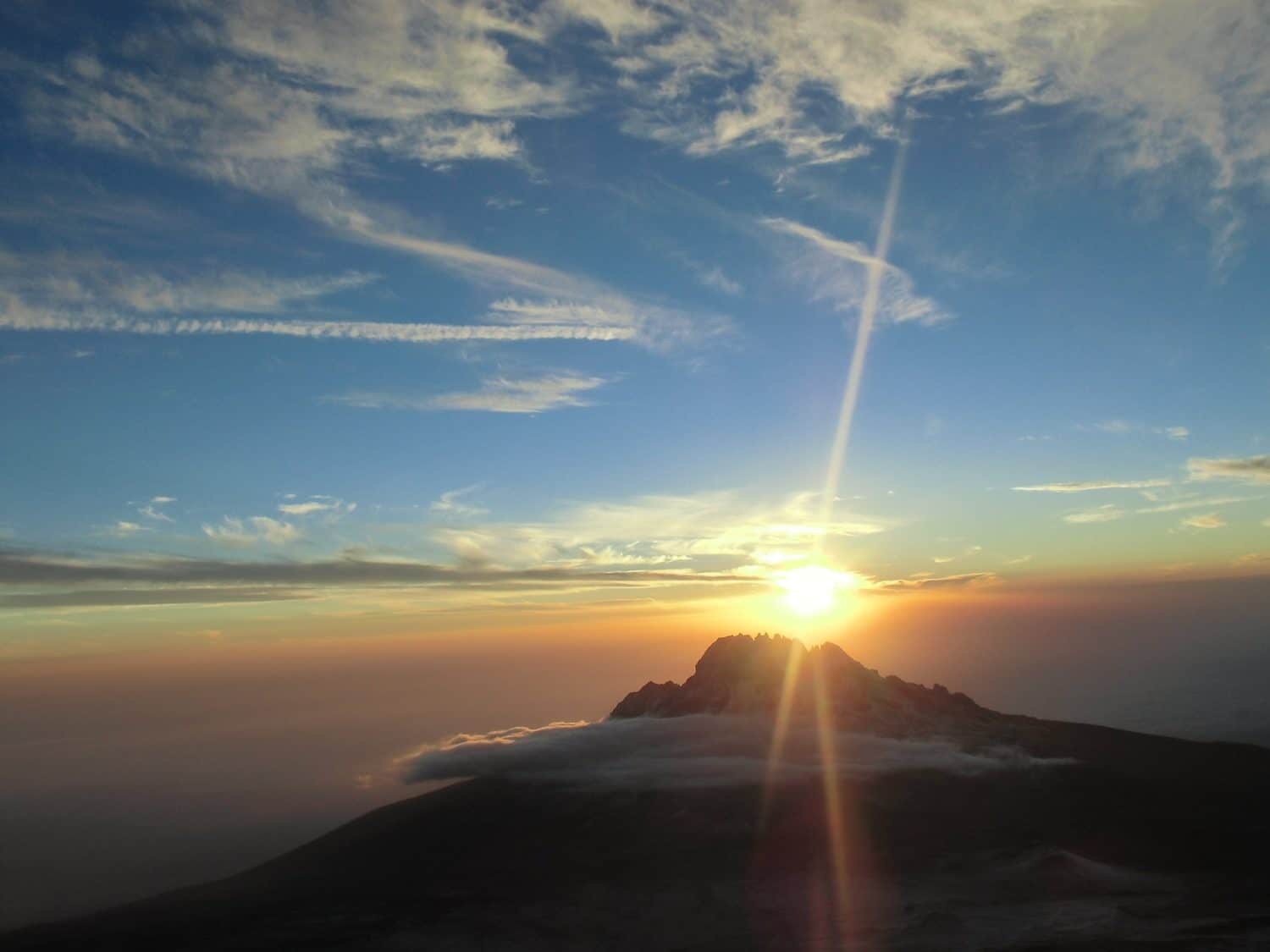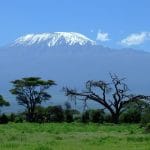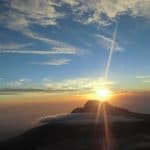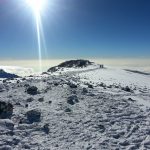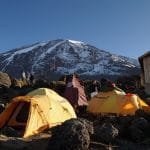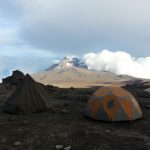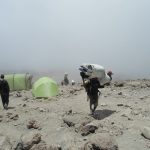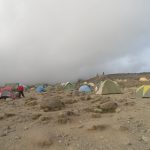Standing at 19,336 feet (5,895 metres), Mt Kilimanjaro is the highest peak in Africa and the largest freestanding mountain in the world. It is also one of the world’s only summits of similar height that can be accessed by a wide range of hikers of different fitness levels and abilities. Climbing Mt Kilimanjaro is a once in a lifetime experience and a draw for mountaineers and thrill-seekers the world over.
The park itself displays an astounding variety of environments. At lower altitudes, the mountain forest provides a home for elephants, buffalo and primates. Climb higher and the forest is overtaken by moorland topography. Higher still and you will come into the alpine desert zone. Finally, the ascent takes you to a glacier of snow and ice, where you stand, on the roof of Africa.
Wild Africa Travel Company can help you prepare for this amazing adventure!
For those not wanting to climb, you can view this beautiful mountain from the town of Moshi or even take a day hike on the base of the mountain.
There are 7 routes to climb Mt Kilimanjaro:
| Route | Recommendation | Suggested Days | Fitness Difficulty | Scenic Beauty | Traffic |
|---|---|---|---|---|---|
| Machame | Highly recommended | 6 or 7 days | High | Excellent | High |
| Lemosho | Highly recommended | 7 or 8 days | High | Excellent | Medium |
| Northern Circuit | Highly recommended | 9 days | High | Excellent | Very low |
| Rongai | Recommended | 6 to 7 days | High | Very good | Low |
| Marangu | Rarely recommended | 6 or 7 days | Medium | Good | High |
| Shira | Not recomended | 6 or 7 dyas | High | Excellent | Medium |
| Umbwe | Not recommended | 5 or 6 days | Very high | Very good | High |
Machame Route
Known as the “Whiskey route”, Machame is by far the most popular route and has a very high success rate of making it to the top. It starts with a nice day of walking through the rainforest and has a nice steady altitude increase each day. Curling around the mountain gives you a variety of different views and beautiful landscapes. For African Scenic Safaris, this is our most popular route and enjoyed by a high percentage of our clients.
6 Day Machame Route – 7 Day Macahme Route
Lemosho Route
This route is extremely beautiful and has a high success rate, like Machame route. You would choose this route if you wanted a more private experience with less climbers. However you will pay a little more, due to the starting point being around the other side of the mountain and higher transport costs in getting yourself and the crew there. It is one of our favourite routes because it offers a great balance of high summit success rate, scenic views and low traffic.
7 Day Lemosho Route
Northern Circuit Route
This is the newest, most exciting route on Kilimanjaro. The trek follows the Lemosho trail in the beginning, approaching Kilimanjaro from the west. However, instead of following the southern traverse like all the other west approaching routes, the Northern Circuit traverses the mountain around the quiet, rarely visited northern slopes. This is a nine day climb, which is the longest route in terms of time and distance travelled. Although it is the most expensive climb option, the small amount of climbers offers a secluded and unique experience, with a very high success rate.
9 Day Northen Circuit Route
Rongai Route
This route is popular for more experienced climbers and offers a greater challenge, especially on summit night. It is the only route that approaches Kilimanjaro from the north, close to the Kenyan Border. It is slightly more expensive due to the additional transport costs in getting to/from the park entry gate and therefore it is less crowded. This route provides more shelter from the weather and high winds and descends via the Marangu route.
Marangu Route
Known as the “Coco-Cola route”, the Marangu route is the oldest and most well established route. Some prefer this route because the accommodation is in huts, rather than camping however it is less private than having your own tent. During peak season these huts can be very overcrowded. We avoid leading climbs on this route as it’s the least scenic route and does not offer good acclimatisation opportunities – therefore a low success rate.
Shira Route
The first day of this route is the Shira Route and then it meets up with the Lemosho route for the rest of the climb. Although distance is shorter than the start of the Lemosho route it is much steeper. Shira is a varied and beautiful route however Lemosho is recommended over Shira due to the high altitude of Shira’s starting point. It is possible that climbers will experience altitude related symptoms on the first day due to lack of acclimatization time.
Umbwe Route
Umbwe route is a short, steep and direct route. It is a very strenuous walk up very steep paths and only recommended for experienced climbers. Although the traffic on this route is low, the chances of success are also low. This route is not recommended.
For further information – Wikitravel- Climb Mount Kilimanjaro
Success Rate
Our climb ground operator enjoys a success rate of over 96% of our their making it to the top of Mt Kilimanjaro. This is Stella or Uhuru Peak and an extremely high success rate. This is due to their fantastic guides who are dedicated and passionate about getting you safely to the summit. They walk slower than most other guides, which is a secret to preventing altitude sickness and increasing your changes of making it to the top.
Our Guides
Our Kilimanjaro head guides receive Wilderness First Responder Medical Training. This is the highest first aid and medical training which specialises on dealing with emergency situations in remote settings. They have worked on Mt Kilimanjaro for a minimum of 10 years each and are a true asset. They will not only guide you up this incredible mountain but will teach you about the Tanzanian culture and way of life.
Our Equipment
Our climb ground operator prides themselves in quality equipment and do everything possible to make their clients comfortable. Their client sleeping tents are imported from the UK and are 5 season mountain tents. Should you wish for the use of a private toilet on your climb, this can be added for an additional cost.
Preparing for Climbing Mt Kilimanjaro
Hiking to the ‘roof of Africa’ — is the adventure of a lifetime, especially since everyone, from seasoned trekkers to first- time enthusiasts can scale the snowy peak.
Although no previous climbing experience is necessary, it’s important to prepare yourself as much as possible, to help you achieve this amazing accomplishment.
Equipment
The communal items are supplied like tents and cooking utensils however you will need to bring all personal items, clothing, sleeping bags and sleeping mats. Upon inquiring with African Scenic Safaris, you will be given a full pre-climb information kit, which includes a hiring price list. Many of these items are expensive to buy from home therefore we offer an inexpensive hiring service in Moshi.
The day before your climb, we will give you a climb briefing, equipment check and help you hire anything additional you need.
Physical
Climbing Mount Kilimanjaro is a physical undertaking, so you should prepare yourself accordingly. Being in good shape is important in many respects. Obviously, strong legs make it easier to walk uphill and downhill for sustained periods of time whereas aerobic fitness allows the body to function efficiently with less oxygen. A fit body is more likely to withstand the stress of consecutive days of hiking.
The best training for a Mt Kilimanjaro climb is walking – the same as you will be doing on the mountain. Walk as often as you can and as much as you can. Wear the boots you will be wearing on the climb, especially if they are new. If you’ve never done much hiking, start a few months before your departure date and start slowly. Try it with a backpack weighing 5-8 kilos, which will give you practise in carrying your daypack.
Altitude Sickness
Altitude sickness is caused because the body is not adapting fast enough to the reduced level of oxygen in the air, at an increased height. There are many different symptoms of altitude sickness, but the most common are : headache, lightheadedness, nausea and sometimes a decreased appetite. These mild forms are not serious and may disappear quickly or certainly when you descend at the end of your climb.
The guides are trained and very experienced in accessing your symptoms and will ensure you are well looked after. If you do not feel well during the Kilimanjaro climb, or you find out that one of the other climbers is unwell, please always inform the guide(s). Often all that is needed is a little motivational talk or some medication. If it’s more serious, the guide will organise for you to descend as this is the only way to treat severe altitude sickness.
There is no way to ensure you will not suffer from altitude sickness however there are 3 golden rules, which may assist.
- Walk slowly – this allows your body more time to acclimatise. Our guides are particularly slow paced, which is why we have such a high success rate of making it to the top.
- Drinks plenty of water, 3-4 litres per day.
- Give yourself the most amount of days possible on the mountain, at least 6 days, however 7, 8 or 9 is even better.
There is a medication called Diamox, which is an altitude prevention medication. It works by acidifying the blood, which stimulates breathing and therefore allowing a greater amount of oxygen to enter into the bloodstream. We have seen a higher success rate from clients who are taking this however you need to speak to your doctor before travelling because in most countries, this is a prescription medication and he/she will need to discuss whether it’s right for you.
For many people, the most important thing once on the mountain, is a positive mental attitude, which can work wonders for you when fatigue and doubts arise. Be positive, relax and enjoy this incredible experience.
For further information – Wikitravel- Climb Mount Kilimanjaro
We have a range of Tanzania tours & safaris available which can be customised with more or less nights as well as activities.





